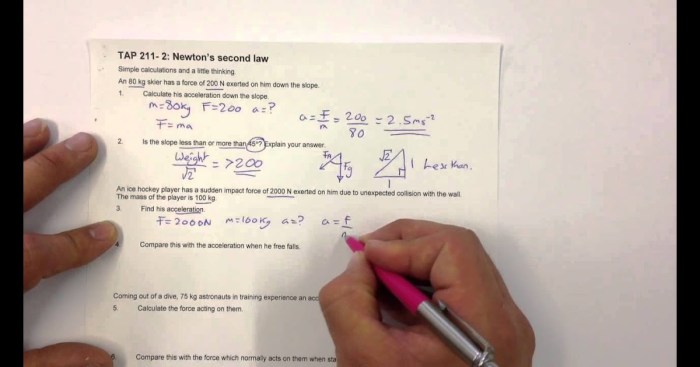Embarking on a journey through Conceptual Physics Practice Page Chapter 3, we delve into the fundamental principles governing the physical world, exploring the concepts of motion, energy, and momentum. From Newton’s groundbreaking laws to the intricacies of rotational motion, this chapter provides a comprehensive understanding of the forces that shape our universe.
As we navigate through this chapter, we will unravel the mysteries of circular motion and centripetal force, examining the relationship between these concepts and Newton’s laws. We will also explore the profound law of universal gravitation, delving into its implications for celestial bodies and our understanding of the cosmos.
Chapter 3 Overview
Chapter 3 of Conceptual Physics provides a comprehensive overview of the fundamental principles governing motion and energy. It introduces Newton’s Laws of Motion, which form the cornerstone of classical mechanics, and explores their applications in analyzing various physical phenomena.
The chapter also delves into circular motion, gravitation, work, energy, momentum, collisions, and rotational motion. Through real-world examples and practical applications, it illustrates how these concepts shape our understanding of the physical world.
Newton’s Laws of Motion

Sir Isaac Newton’s three Laws of Motion are fundamental principles that describe the behavior of objects in motion. They provide a framework for analyzing and predicting the motion of objects under the influence of external forces.
Newton’s First Law of Motion (Law of Inertia)
An object at rest will remain at rest, and an object in motion will remain in motion with the same speed and in the same direction unless acted upon by an unbalanced force.
Newton’s Second Law of Motion (Law of Acceleration)
The acceleration of an object is directly proportional to the net force acting on it and inversely proportional to its mass. Mathematically, this can be expressed as: F = ma, where F is the net force, m is the mass of the object, and a is its acceleration.
Newton’s Third Law of Motion (Law of Action and Reaction), Conceptual physics practice page chapter 3
For every action, there is an equal and opposite reaction. When one object exerts a force on a second object, the second object exerts an equal and opposite force on the first.
Applications of Newton’s Laws
Newton’s Laws of Motion have widespread applications in various fields, including engineering, physics, and everyday life. They provide a powerful tool for analyzing and predicting the motion of objects in a wide range of situations.
Examples of applications include:
- Designing and analyzing structures such as bridges and buildings
- Predicting the trajectory of projectiles and rockets
- Understanding the forces involved in sports and other physical activities
- Developing new technologies, such as spacecraft and medical devices
Circular Motion and Gravitation
Circular motion occurs when an object moves in a circular path around a fixed point. Centripetal force is the force that keeps the object moving in a circular path. Newton’s Laws of Motion can be used to analyze circular motion.
Gravitation is the force of attraction between two objects with mass. The law of universal gravitation states that the force of attraction between two objects is directly proportional to their masses and inversely proportional to the square of the distance between them.
Work and Energy: Conceptual Physics Practice Page Chapter 3
Work is done when a force is applied to an object and the object moves in the direction of the force. Energy is the ability to do work. There are different forms of energy, including kinetic energy, potential energy, and thermal energy.
The law of conservation of energy states that the total energy of a closed system remains constant. Energy can be transferred from one form to another, but it cannot be created or destroyed.
Momentum and Collisions
Momentum is a measure of the motion of an object. It is defined as the product of the object’s mass and velocity. The law of conservation of momentum states that the total momentum of a closed system remains constant.
Collisions are events in which two or more objects interact. There are different types of collisions, including elastic collisions and inelastic collisions.
Rotational Motion
Rotational motion occurs when an object rotates around an axis. Torque is the force that causes an object to rotate. The law of conservation of angular momentum states that the total angular momentum of a closed system remains constant.
Rotational motion is found in a wide variety of applications, including motors, engines, and gyroscopes.
Practice Problems
A set of practice problems is provided to help students test their understanding of the concepts covered in Chapter 3. Step-by-step solutions to the problems are included.
FAQ Resource
What is the significance of Newton’s First Law of Motion?
Newton’s First Law of Motion, also known as the law of inertia, establishes the principle that an object at rest will remain at rest, and an object in motion will continue moving at a constant velocity in a straight line unless acted upon by an external force.
How does circular motion relate to Newton’s laws?
Circular motion is a special case of motion where an object moves in a circular path. Newton’s laws can be applied to circular motion by considering the centripetal force, which is the force that keeps the object moving in a circular path.
What is the law of conservation of energy?
The law of conservation of energy states that the total energy of an isolated system remains constant. Energy can be transformed from one form to another, but it cannot be created or destroyed.
